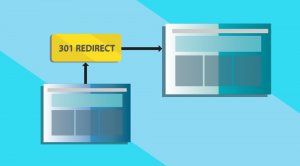Despite all the information out there, 301 redirects and their purpose can still be confusing.
301 redirects are most likely found on nearly all sites you visit, though you may not have noticed.
We’ll break things down for you in an easy-to-understand way, so you are able to confidently move forward with your redirects, without worrying about your page rankings.
Let’s talk basics
What is a 301 redirect? What does it mean?

Now that we have the definition, let’s put it into context.
301 redirects and when to use them
There are three main reasons to use 301 redirects.
- To ensure optimized Domain Authority.
- To direct URLs owned by your company to one main website.
- To rebrand or rename your website.
Reasons #1 and #2 go hand in hand. By directing different URLs to one main URL, you are optimizing your Domain Authority and Google Indexing by not splitting your rankings among multiple URLs.
According to Moz, 90-99 percent of ranking power is passed to the redirected page. So, you are in the clear when you use 301 redirects to your website in regards to maintaining your search rankings.
For example:
If you type proqsolutions.com in your browser, you will be redirected to https://www.proqsolutions.com. The same thing happens if you type in www.proqsolutions.com.
Another example of 301 redirects is by typing hubspot.com/blog in your browser and being redirected to https://blog.hubspot.com.
If you are rebranding or renaming your website or business, then you will also want to set up a 301 permanent redirect. When renaming your business or setting up a URL, you “don’t want to lose your existing content or the links pointing to the original URL. So you set up a 301 [re]direct. The redirects preserve your links and authority while letting you focus on building or promoting a new brand.”
The most infamous case of a business not setting up a 301 redirect when changing domain names was the now-defunct Toys “R” Us. Toys “R” Us purchased the toys.com domain in hopes to boost some of their organic search results. While they did change their domain, unfortunately, they did not set up a 301 redirect from their old site.
It’s easy to guess what happened.
Because Google saw toys.com as a new domain with no Domain or Page Authority or inbound links, the Toys “R” Us rankings disappeared off of the SERP.
How do I know what to set my URL to?
In some cases, this is easy. Like the Hubspot example above, the overall look of the URL in the browser looks cleaner and easier to remember. This is ideal for blogs.
If you are a bank, an e-commerce site, or any site that sells a product online, then having HTTPS in the browser will help users feel secure enough to enter their personal information on your site when buying your product.
Regardless of the nature of your company, you do need to use HTTPS no matter what you choose to show in the search bar. If you don’t, you’ll see a warning like this

Google representatives advocate for HTTPS, and you may encounter SEO disadvantages in your efforts. More information on HTTPS and Google can be found at Bright Edge.
301 redirects can cause headaches if not done right
As a web development and marketing agency, we have seen firsthand how wrong 301 redirects can go. You shouldn’t be scared to use them — they are essential for SEO purposes. However, you do need to be cautious when making any kind of redirect change.
We had a client who insisted on reducing all the pages on their website from around 1,500 products down to 300, with all their product variations reduced as well. We objected to this request from an SEO standpoint but did end up following our client’s wishes in the end. The result was a major loss in revenue for our client.
So, what went wrong? We reduced the number of pages and didn’t 301 redirect pages with no traffic. When the site was launched with hundreds of pages gone, the entire site’s rankings went down and their Domain Authority had fallen.
This was because even though so many of their pages had a seemingly insignificant amount of monthly views, those hundreds of pages that had existed for years did build our client link equity and upped their domain authority. Without those pages, their site dropped from the SERP.
What we and our client learned from this was to always 301 redirect every page, on every site, all the time. URL structure is critical to think about when changing your site.
While our client was able to recover, there are companies who have gone out of business because of 301 redirect errors. Don’t let yours be one of them.
Other forms of redirects
There are other forms of redirects beyond the 301. While 301 redirects are what you will almost always use, there are cases where another option is best.
302 redirects are temporary redirects. These are useful when you want Google to continue to index your old page. If you put your site under construction or are conducting A/B testing, search engines will see that this redirect is only temporary.
Be aware that when using 302 redirects, your link equity is not passed on.
Meta refreshes aren’t technically redirects, but instead instruct the browser to refresh the page after a certain amount of time. If you go to a website that is using a meta refresh, you’ll get a message saying something like, “To continue to this domain, click here or your browser will automatically refresh and take you there in 7 seconds.”
Generally, meta refreshes aren’t recommended, as they can be flagged as spam, usually rightfully so. Use meta refreshers if your web host doesn’t allow for 301 redirects.
For SEO purposes, a 301 redirect is always going to be your best option.
How to set up 301 redirects
We could tell you how to set up 301 redirects in WordPress, but WordPress already created a handy and easy-to-understand guide to help you out. There are multiple plugins you can use to make 301 redirects simple.
The quick guide to canonical URLs
If you’re a beginner in the world of redirects, then understanding canonical URLs is important. Essentially, what canonical means in SEO terms is that “this site is the REAL site — it’s ‘canon.’”
Using canonical tags in your redirect rules allow you to inform search engines where credit should be sent.
They go hand in hand with 301 redirects. These take your users to the domain you want them to go to, and the canonical tags ensure that Google doesn’t create two listings for the same page.
Canonically speaking, proqsolutions.com and https://www.proqsolutions.com are the same site, and canonical tags let Google know not to index them twice.
A rel=canonical tag is useful when you have duplicate content on your site but don’t want to get penalized by Google. This happens often with e-commerce sites, as products can have several URLs, depending on how a user got there.
Pick the page that will be the canonical version — that is to say, the page you believe is the most important. Add a rel=canonical tag in the page’s code, and you’re all set.
Your site and 301 redirects
While there are cases of 301 redirects causing headaches to businesses (like Toys “R” Us and one of our clients), they are essential for SEO purposes and the success of your site.
These redirects are fairly straightforward and will increase your domain authority and searchability in the SERP.
If you have any questions regarding 301 redirects, contact us for a free 30-minute consultation.